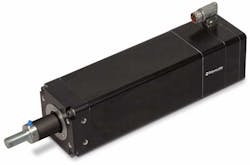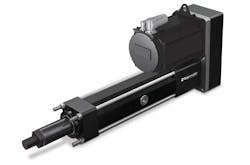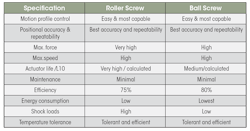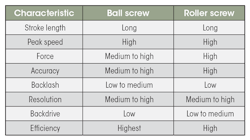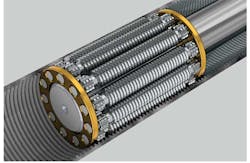What’s the Difference Between Roller and Ball Screws?
Ball screws and roller screws are widely used for high-force linear motion and are replacing fluid power devices. In general, these screw mechanisms generate linear motion by rotating either the screw or nut in an assembly. The screw is a cylindrical element with threads, and the nut is a matching component that rides on the screw. Each component can rotate independently of the other, but the linear motion is created by restraining either the screw or nut.
Here’s a closer look at each device and the differences between them.
Ball Screw Basics
Ball screws get their name from the re-circulating ball bearings that fit between the screw’s arch-shaped screw threads and the nut’s corresponding threads. The bearings transmit force and relative motion as they roll through one or more circuits in the nut.
Ball screw actuators have high thrust capabilities, long service lives and efficiencies of around 80%. They can be backdriven. They can also be noisy. Ball screws are well suited for applications requiring high duty cycles and moderately high thrust. They tend to be reasonably priced, making them popular in many applications.
The ball bearings roll and recirculate through one of several circuits in the nut. The number of bearing paths and how the bearings recirculate can be tailored to meet the application’s needs. The ball bearing path, for example, can be changed to adjust the ball screw’s top speed. Engineers can also specify different internal paths and end returns that increase the balls screw’s speed and noise levels.
Ball screws come in a wide variety of diameters, leads and accuracies with both metric and imperial lead designs. A grade system regulated by ISO-3408 classifies the lead accuracies of ball screws. Ball screws are commonly available in five grades that range in accuracy from 6 mm per 300 mm (0.0002 in. per ft) to 210 mm per 300 mm (0.0080 in. per ft).
Roller Screw Basics
In roller screws, the actuator’s force is transmitted through several threaded rollers in the nut, and the threads are generally triangular. The rollers rotate within the nut and are in contact with the screw’s threads to power the screw’s motion. The rollers offer more contact areas, which gives them efficiencies from 75 to 80%.
Roller screws, like ball screws, fall within the ISO-3408 grading system so they share similar lead accuracy considerations. Standard roller screws are hardened before being precision ground, giving them much deeper hardnesses and the highest dynamic load rating.
Another type of roller screw—the inverted planetary roller screw—operates in much the same way as standard roller screws, except the functions of the nut and screw are reversed and the rollers move inside the nut.
Most inverted roller screws do not have ground threads inside the nut. Instead, a less expensive machining method creates those threads. The threads are then hardened after the nut is machined, leaving a much shallower case hardness depth and softer threads than those in standard roller screws. This leads to a significantly shorter life and more challenges with maintaining lubrication. But inverted rollers let the actuator be smaller for applications with tight space limitations.
Comparing the Two
Here’s a rundown of how the two screws stack up to each other in various categories:
Operational life. Ball screws have moderately long and predictable lives in properly designed high-force applications. But roller screws’ lives can be several times longer than those of ball screws, thanks to more points of contact and improved distribution of force.
Forces. Ball screws can generate forces as high as roller screws, but the actuator/machine footprint will be larger and the operating life will be shorter. In extreme high-force, high-duty-cycle applications, roller screws deliver better performance, compact footprints, longer lives and lower costs of ownership compared to ball screws.
In low- to moderate-force positioning applications, ball-screw actuators have lower initial costs, more versatility and lower power consumption.
Maintenance. Ball screws need little maintenance requirements. The ball nut assembly must be periodically lubricated, depending on the severity of the application. Ball screws also have fewer contact points, making them more efficient at heat management than roller screws. This lets them operate cooler in high duty-cycle and high-speed applications. Heat management helps determine how well lubricants hold up over time and whether the actuator/screw choice will last as long as expected.
Maintenance on roller screws is also minimal, but high duty-cycle applications may demand occasional relubrication of the roller nut.
Contact area. On roller screws, through-hardened, precision-ground threads on the rollers and shaft provide maximum contact areas. This lets them generate greater and more uniformly distributed forces and gives them longer service lives compared to ball screws.
Compact design. Roller screws create higher forces in a smaller package compared to ball screws.
Low life-cycle costs. Roller-screw actuators deliver lower operating costs than fluid power cylinders due to greater efficiency and energy savings. But, depending on the application, a roller screw’s high load rating DLR and longer life can lead to lower total cost of ownership compared to ball screws. And roller screws tolerate high duty-cycles (up to 100 %) at moderate speeds and working forces.
To get the right screw drive, designers need to let the application specifications be the guide. Every application is different, and both roller and ball screws have their place. But evaluating the application and both technologies ensures the best balance of performance and cost.
When trying to decide whether to go with ball screws or roller screws, it is best to work with suppliers that have expertise in both (some companies sell only one type of screw). Doing so ensures the most appropriate screw is used to get the targeted performance at the lowest possible life-cycle cost.

